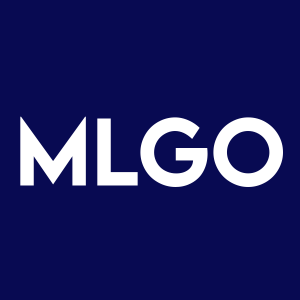MicroAlgo Inc. Develops Quantum Convolutional Neural Network (QCNN) Architecture to Enhance the Performance of Traditional Computer Vision Tasks Using Quantum Mechanics Principles
Rhea-AI Summary
Positive
- Development of innovative QCNN architecture combining quantum and classical computing advantages
- Potential applications across multiple high-value industries including autonomous driving and medical imaging
- Technology promises enhanced computational speed and image recognition accuracy
Negative
- Early-stage research with no proven commercial implementation yet
- No specific timeline or commercialization roadmap provided
- High technical complexity may pose implementation challenges
News Market Reaction 1 Alert
On the day this news was published, MLGO gained 33.76%, reflecting a significant positive market reaction.
Data tracked by StockTitan Argus on the day of publication.
The Quantum Convolutional Neural Network (QCNN) architecture is an innovative computational model that cleverly combines the parallelism of quantum computing with the feature extraction capabilities of classical convolutional neural networks. In QCNN, quantum bits (qubits) serve as the basic carrier of information, utilizing the properties of quantum superposition and entanglement to achieve parallel processing of multiple computational tasks. At the same time, drawing inspiration from the structure of classical convolutional neural networks—such as convolution layers, pooling layers, and fully connected layers—QCNN extracts features, reduces dimensions, and classifies image data, thereby enhancing both computational speed and image recognition accuracy.
Computer vision aims to enable computers to understand and analyze visual data, such as images or videos, much like the human visual system, involving tasks such as image recognition, object detection, and image segmentation. Quantum computing, with its unique quantum properties like superposition and entanglement, possesses powerful parallel computing capabilities and specialized methods of information processing.
Data Preparation: Image or video data is collected from multiple channels, then screened and organized to remove low-quality or non-compliant data. The remaining data is preprocessed, including normalizing pixel values, resizing images, and correcting and enhancing colors to meet the specifications for subsequent processing.
Quantum State Encoding: Following specific rules, the preprocessed image features are mapped onto quantum bits and converted into quantum states. By utilizing the properties of quantum superposition and entanglement, relationships between features are established, forming a complex network of feature associations.
Quantum Convolutional Neural Network (QCNN) Processing: The quantum convolutional layer takes advantage of quantum parallelism, using multiple convolutional kernels to extract features represented by quantum states and uncover deeper features. The quantum pooling layer performs dimensionality reduction on the extracted features, retaining key features while alleviating the computational burden in subsequent stages. The quantum fully connected layer analyzes the reduced features and classifies them based on quantum state correlations.
Quantum Measurement and Output: Through appropriate quantum measurement operations, the quantum state results are converted into classical data forms. Outputs such as target categories, locations, and other relevant information are provided, while the entire process is optimized based on application feedback.
MicroAlgo's QCNN architecture has broad application prospects in the field of computer vision. In autonomous driving, QCNN can enable fast and accurate recognition of key elements such as road signs, vehicles, and pedestrians, enhancing the safety and reliability of autonomous driving systems. In medical imaging analysis, QCNN can achieve rapid and accurate diagnosis of medical images, assisting doctors in disease diagnosis and treatment planning. In security surveillance, QCNN can enable real-time detection and early warning of abnormal behavior in surveillance videos, improving the efficiency and accuracy of security measures. Additionally, QCNN can be widely applied in various fields such as smart manufacturing, aerospace, and smart cities, driving technological upgrades and intelligent transformations in related industries.
About MicroAlgo Inc.
MicroAlgo Inc. (the "MicroAlgo"), a Cayman Islands exempted company, is dedicated to the development and application of bespoke central processing algorithms. MicroAlgo provides comprehensive solutions to customers by integrating central processing algorithms with software or hardware, or both, thereby helping them to increase the number of customers, improve end-user satisfaction, achieve direct cost savings, reduce power consumption, and achieve technical goals. The range of MicroAlgo's services includes algorithm optimization, accelerating computing power without the need for hardware upgrades, lightweight data processing, and data intelligence services. MicroAlgo's ability to efficiently deliver software and hardware optimization to customers through bespoke central processing algorithms serves as a driving force for MicroAlgo's long-term development.
Forward-Looking Statements
This press release contains statements that may constitute "forward-looking statements." Forward-looking statements are subject to numerous conditions, many of which are beyond the control of MicroAlgo, including those set forth in the Risk Factors section of MicroAlgo's periodic reports on Forms 10-K and 8-K filed with the SEC. Copies are available on the SEC's website, www.sec.gov. Words such as "expect," "estimate," "project," "budget," "forecast," "anticipate," "intend," "plan," "may," "will," "could," "should," "believes," "predicts," "potential," "continue," and similar expressions are intended to identify such forward-looking statements. These forward-looking statements include, without limitation, MicroAlgo's expectations with respect to future performance and anticipated financial impacts of the business transaction.
MicroAlgo undertakes no obligation to update these statements for revisions or changes after the date of this release, except as may be required by law.
SOURCE Microalgo.INC






